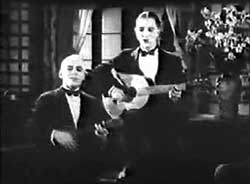 An early Vitaphone short-short Witt & Berg: Premiere Entertainers (1926) features the titularly named vaudeville duo, tiny little Bob Witt with his tiny little ukelele, & tall Cy Berg with guitar.
An early Vitaphone short-short Witt & Berg: Premiere Entertainers (1926) features the titularly named vaudeville duo, tiny little Bob Witt with his tiny little ukelele, & tall Cy Berg with guitar.
Forgotten now, Witt & Berg were a crowd-drawing comedy team in their day. However, this number is not such much comedy, though it is cute. It's pretty much a straightforward ragtime piece called "Hawaiian Song," with cutesy-poo "wicky wicky wacky woo" lyrics.
The extremely early sound film was extremely short because an all-sound film was still experimental. It was originally shown with a record playing separate form the film.
It was filmed simultaneously with another early-as-they-come sound film, The Voice from the Screen (1926). This Vitaphone short-short sets out to show, at Bell labs, how the new sound system works.
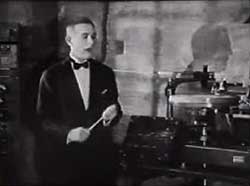 After showing us the recording equipment, we see from behind the camera & behind the sound system the making of Witt & Berg: Premiere Entertainers. After showing us the recording equipment, we see from behind the camera & behind the sound system the making of Witt & Berg: Premiere Entertainers.
This is followed by the presenter showing us the electric projecting machine that both plays the record & projects the film.
The next year this system was used to make The Jazz Singer (1927), usually called the first talkie though it was more accurately the first feature length talkie.
Predating it by quite some months was not only the trial-film Witt & Berg, & Voice from the Screen,but also an advance promotional trailer for The Jazz Singer featuring John Mill John talking from the screen about the forthcoming film to star Al Jolsen.
The crew is not named for these films, but the presenter seen in Voice calls out at one point, "Heller, are you ready?" which would be Herman S. Heller as musical director. He may have been the primary director as well, but he also worked around this time with Roy Del Ruth in who may well be the director, though Bryan Foy is another possibility.
The Voice from the Screen is included on a special three-disc dvd Warner Home Video 2007 speical release of The Jazz Singer. It's on Disc 2: The Early Sound Era also called The Jazz Singer Extras: Disc 1. On Disc 3: Vitaphone Shorts, also called The Jazz Singer Extras Disc 2, there's a large array of early Vitaphone short comedies & musical acts.
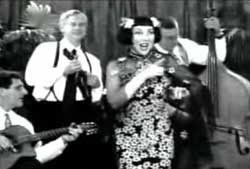 Starring Janet Klein & her Parlor Boys, the mispelled-on-the-title-card Yidish Hula Boy (2003) is tricked out to look like a vintage Vitaphone musical short of the late 1920s.
Starring Janet Klein & her Parlor Boys, the mispelled-on-the-title-card Yidish Hula Boy (2003) is tricked out to look like a vintage Vitaphone musical short of the late 1920s.
"The Yiddish Hula Boy (Becky I Ain't Comin' Back)" is a truly old-fashioned novelty song such as would've been sung in the Hester Street music halls early in the last century -- which is, of course, exactly what it is.
Janet Klein sings it if not quite with professional power, then with enormous charm, backed up by her Parlor Boys, who are geezers on ukelele (Ian Whitcomb), guitar (Tom Marion), slide guidar (Russ Blake), & bass (David Jones). And hula dancer Farrah Lynch provides a suitable performance at the side, with a very funny farewell at the close.
In the "old" black & white film, Janet is kind of dressed faux-Asian as she sings about a certain taylor named Cohen who went to Honolulu, fell for the "hula dollies," & wrote his wife Becky that he was never coming home. This magically nostalgic short film can be viewed at youtube, or check out janetklein.com.
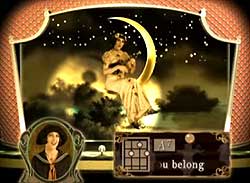 A totally oddball music video is How To Play 'Tonight You Belong To Me' (2005). On a strangely artificial stage that looks like it's about thirteen inches tall, Janet Klein walks out & stands center stage reading a "Dear ukelele gal" letter with a particular song request, a 1927 Billy Rose & Lee David number.
A totally oddball music video is How To Play 'Tonight You Belong To Me' (2005). On a strangely artificial stage that looks like it's about thirteen inches tall, Janet Klein walks out & stands center stage reading a "Dear ukelele gal" letter with a particular song request, a 1927 Billy Rose & Lee David number.
Janet says, "Let's all learn it together," as the curtain closes & reopens to reveal Klein projected onto a screen giving a ukelele lesson on how to play "Tonight You Belong to Me."
Two-thirds of the four minute twenty second film are over by the time she begins to perform the song, with words appearing on the screen for those of us inclined to sing along.
She unfortunately switched keys & if you follow her directions on how to play along on a ukelele, you'll think you're a total screw-up not to be able to play such a simple thing, but it's Janet's doing, & kind of mean of her.
The curtain of the miniature stage closes again & when it opens, our eight inch tall singing gal is lowered from above, seated in a crescent moon, & she sings this number as sweetly as it can be sung, harmonizing with herself as she also appears in a round cameo at the lower left hand of the screen accompanying herself.
The film's only fault is the singing portion of it, the strong part, is only about a minute. But the design of this short-short is very appealing, as is, as always, Janet Klein.
This short-short was included on the a dvd re-issue of Steve Martin's film The Jerk (1979), in which the song is performed. You can also see it at youtube, then ponder visiting Janet's website to purchase a CD or two of her clear simple arrangements of jazz & pop tunes from the first thirty years of the century.
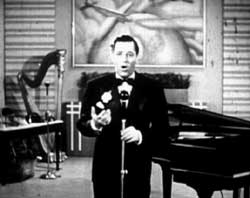 Irish American tenor Michael Bartlett, backed by the Geroge Steiner Orchestra, sings the chestnut Mother Machree (1941) in a style that must go back to the mid 19th Century. Anyone who likes such modern crap as "the Three Irish Tenors" raising funds on PBS, then Bartlett's going to be a hot-cha-cha singer, despite that it's deeply saccharine.
Irish American tenor Michael Bartlett, backed by the Geroge Steiner Orchestra, sings the chestnut Mother Machree (1941) in a style that must go back to the mid 19th Century. Anyone who likes such modern crap as "the Three Irish Tenors" raising funds on PBS, then Bartlett's going to be a hot-cha-cha singer, despite that it's deeply saccharine.
Bartlett stands on a stage decked out like a music room with piano, harp, a couple microphones, though he's singing a capella & no one else is in the room. The painting on the back wall depicts art deco jets & propeller planes.
The camera pans in on the singer then cuts suddenly to a working class cafe, with waitress & a couple Irish guys getting misty-eyed hearing Bartlett on the radio. This is followed by other cuts to people un other settingslistening to the same radio show, then to the warfront where he's being listened to on a wind-up Victrola.
As the song is finishing up, the camera pans away &ajmp reveals that the music room is indeed a sound room at a radio station, & we're looking through the window from where the sound engineers are seated. It's a surprisingly effective soundie to be so absurdly misty-eyed.
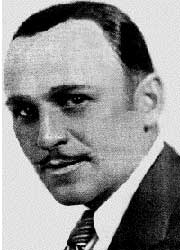 A Metro-Goldwyn-Mayor Movietone sound film made at the Capitol Theater in New York, Walter Roesner & the Capitolians (1928) is a big big band which begins with some corn, with a vocalist leading off with "Angela Mia (O Solo Mio)" then loud instrumentation of the sort that could be used to put infants to sleep just from the tedium, including heavenly harp strokes before that crummy singer returns.
A Metro-Goldwyn-Mayor Movietone sound film made at the Capitol Theater in New York, Walter Roesner & the Capitolians (1928) is a big big band which begins with some corn, with a vocalist leading off with "Angela Mia (O Solo Mio)" then loud instrumentation of the sort that could be used to put infants to sleep just from the tedium, including heavenly harp strokes before that crummy singer returns.
In 1929 there was still a sizeable white audience reluctant to listen to jazz, an area of music which according to the racism of the day was "tainted" as black music.
So a whitebread band like this one would do a crappy-ass number like "O Solo Mio" that was already old-fashioned, then when they had the audience in their hand, move on to a taste of jazz, which any musician of merit would've been interested in even if the public was a few years shy of ready.
In an eleven minute film they spend five of it on the awful song interesting mainly in showing what white bands were usually doing while up in Harlem & down in New Orleans music was undergoing convulsions of genius.
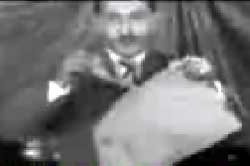 The second half of this film is taken up by the number "Hottest Man in the Band." Roesner asks those of us in the audience to be the judges as to who in the band is the hottest, as we are taken through a series of show-off solo moments. The second half of this film is taken up by the number "Hottest Man in the Band." Roesner asks those of us in the audience to be the judges as to who in the band is the hottest, as we are taken through a series of show-off solo moments.
Now we're seeing the birth of swing & it's ever so much more appealling than "O Solo Mio." There's a sax solo that is cool to the nth degree. Then there's a trumpet solo also pretty winning.
A violinist who just about floored me with the strangest damn solo that has to be seen as well as heard to be believed. One of his violin strings is loose, & instead of bowing his instrument, he keeps dragging his fingernail down the loose string which makes the violin resonate most interestingly, a grinding musicality like an elf playing a miniature violin with a fingernail file.
We then get rousing fast-picking banjo solo, then a clarinet solo (that's Jimmy Dorsey!), every bit of every moment grand, though nothing as freakily cool as that violin.
A vocalist next does "Dinah" in a plain but fine manner with a bit of scat. The drummer who is standing way atop the bandstand has been kind of showy throughout, but now he seems to be playing a piece of cloth by ripping off two-inch pieces one after another treating as music tearing sounds.
Okay, this crazy band starts out with the crummiest old-hat milquetoast number & moves from there to tearing up a pillow case as a substitute for drums. These versatile & entertaining fellows step right out of the predictability factor into the world of strange, & are in the final analysis a remarkable orchestra.
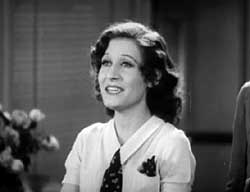 Lois (or Loyis) Whiteman & Harry Barris run into Art Jarrett on board an ocean liner, & join Art together with his father & lady friend, in the opening scene of Rambling Around Radio Row #2 (1932).
Lois (or Loyis) Whiteman & Harry Barris run into Art Jarrett on board an ocean liner, & join Art together with his father & lady friend, in the opening scene of Rambling Around Radio Row #2 (1932).
They're all pulling into New York Harbor after a long voyage, & agree to get together in club on Manhattan where they celebrate their return home.
The designated club is Burton Lane's Cabin, named for its owner, a songwriter not otherwise in this short Vitaphone musical. This is a hangout for songwriters & radio personalities.
Art Jarrett sings Sammy Fain's ragtime jazz number "Hummin' to Myself," with only piano accompaniment. Jarrett had a high-end tenor, near-falsetto voice & he's really extremely good.
He was popular in the 1920s on the live stage & in performance halls. When the talkies arrived by 1929, it was assumed Jarrett would be an even bigger star for the 1930s, but the new era would prefer crooners with somewhat lower voices, & Art ended up in the main a purveyor of sheet music as that industry, too, died away. It's really too bad for among the 1920s white-guy tenors, he was genuinely talented, while the majority were merely fashionable.
It's next Harry Barris's turn. He sits down at the piano & with his leg bouncing a rapid beat, he sings amusingly & well, a ragtime number written by himself, "Music Has Charm."
It runs in part "Now I'm as happy as I can be/ When I'm shoutin' & yellin' mad harmony." Fortunately the tune is better than the lyrics, but unfortunately his career would tank much worse than Art Jarrett's during this decade.
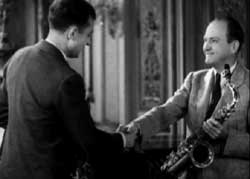 Through the 1940s he'd be playing background band members or tarroom piano players, roles so small he didn't even get a screen credit for showing up. Through the 1940s he'd be playing background band members or tarroom piano players, roles so small he didn't even get a screen credit for showing up.
Nevertheless, a couple of his musical compositions proved to have some lasting power ("Wrap Your Troubles in Your Dreams" & "I Surrender Dear" notably).
Art asks Harry to play that newest composition of his "It Was So Beautiful." He plays it on the piano & Lois Whiteman steps forward to do the lyrics of a love song, not half as thrilling as the pair of songs the two guys sang.
The film has run five minutes to get these three songs & skit completed. Now the one-reeler short leaps to completely different "Radio Row" figures, Rudy Wiedoeft & Benny Krueger. They effect to have just met each other in a huge sitting-room with grand piano. Both men have their saxophones with them, what a coincidence.
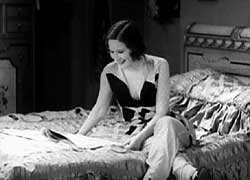 They do a bit of a comedy routine, Ben playing his rendition of a hiccoughing Prohibition era drunkard, then both play laughing saxophones. They do a bit of a comedy routine, Ben playing his rendition of a hiccoughing Prohibition era drunkard, then both play laughing saxophones.
That's about it for them. They don't get to do much that could be regarded as musical before it cuts to Sylvia Froos's hotel room for the third & last musical skit of this Vitaphone musical short.
Sylvia's a darned cute flapper, formerly a child star of the vaudeville stage. She has a great jazz singer voice, sitting on her bed singing to herself:
"The sun's in my heart/ The sun's in my heart/ The clouds disappear/ Whenever you're near/ Close together/ We won't mind the weather/ If it's stormy/ Your two arms will warm me."
She jumps off her bed & starts dancing around as she sings the song specifically to her mother (played by her real mother) who is seated by an endtable. Meanwhile a couple newspaper gossip columnists are spying on her through the keyhole &, it will turn out in the very end, under her bed.
Sylvia's much the best performer in the film, but fact is, none of these stars were going to be around much longer, having come out of vaudeville & never to do much for the movies. New York radio shows was the glass ceiling for the whole lot.
copyright © by Paghat the Ratgirl
|
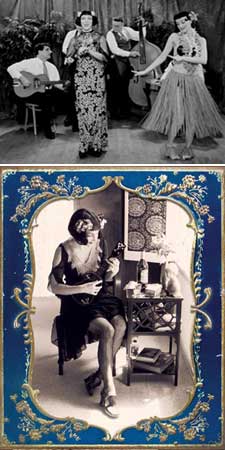

 After showing us the recording equipment, we see from behind the camera & behind the sound system the making of Witt & Berg: Premiere Entertainers.
After showing us the recording equipment, we see from behind the camera & behind the sound system the making of Witt & Berg: Premiere Entertainers.



 The second half of this film is taken up by the number "Hottest Man in the Band." Roesner asks those of us in the audience to be the judges as to who in the band is the hottest, as we are taken through a series of show-off solo moments.
The second half of this film is taken up by the number "Hottest Man in the Band." Roesner asks those of us in the audience to be the judges as to who in the band is the hottest, as we are taken through a series of show-off solo moments.
 Through the 1940s he'd be playing background band members or tarroom piano players, roles so small he didn't even get a screen credit for showing up.
Through the 1940s he'd be playing background band members or tarroom piano players, roles so small he didn't even get a screen credit for showing up. They do a bit of a comedy routine, Ben playing his rendition of a hiccoughing Prohibition era drunkard, then both play laughing saxophones.
They do a bit of a comedy routine, Ben playing his rendition of a hiccoughing Prohibition era drunkard, then both play laughing saxophones.